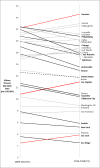Black-White Inequities in Kidney Disease Mortality Across the 30 Most Populous US Cities
- PMID: 35266122
- PMCID: PMC9086025
- DOI: 10.1007/s11606-022-07444-1
Black-White Inequities in Kidney Disease Mortality Across the 30 Most Populous US Cities
Abstract
Objectives: To examine city-level kidney disease mortality rates and Black:White racial inequities for the USA and its largest cities, and to determine if these measures changed over the past decade.
Methods: We used National Vital Statistics System mortality data and American Community Survey population estimates to calculate age-standardized kidney disease mortality rates for the non-Hispanic Black (Black), non-Hispanic White (White), and total populations for the USA and the 30 most populous US cities. We examined two time points, 2008-2013 (T1) and 2014-2018 (T2), and assessed changes in rates and inequities over time. Racial inequities were measured with Black:White mortality rate ratios and rate differences.
Results: Kidney disease mortality rates varied from 2.5 (per 100,000) in San Diego to 24.6 in Houston at T2. The Black kidney disease mortality rate was higher than the White rate in the USA and all cities studied at both time points. In T2, the Black mortality rate ranged from 7.9 in New York to 45.4 in Charlotte, while the White mortality rate ranged from 2.0 in San Diego to 18.6 in Indianapolis. At T2, the Black:White rate ratio ranged from 1.79 (95% CI 1.62-1.99) in Philadelphia to 5.25 (95% CI 3.40-8.10) in Washington, DC, compared to the US rate ratio of 2.28 (95% CI 2.25-2.30). Between T1 and T2, only one city (Nashville) saw a significant decrease in the Black:White mortality gap.
Conclusions: The largest US cities experience widely varying kidney disease mortality rates and widespread racial inequities. These local data on racial inequities in kidney disease mortality can be used by city leaders and health stakeholders to increase awareness, guide the allocation of limited resources, monitor trends over time, and support targeted population health strategies.
Keywords: city; health disparities; kidney disease; mortality; nephrology; place; race; racial inequity; structural racism.
© 2022. The Author(s) under exclusive licence to Society of General Internal Medicine.
Conflict of interest statement
The authors declare that they do not have a conflict of interest.
Figures


Comment in
-
Kidney Disease Mortality in the USA: a Call for Eliminating Inequities.J Gen Intern Med. 2022 May;37(6):1349-1350. doi: 10.1007/s11606-022-07470-z. J Gen Intern Med. 2022. PMID: 35266126 Free PMC article. No abstract available.
References
-
- Kochanek KD, Murphy SL, Xu J, Arias E. Deaths: Final Data for 2017. Natl Vital Stat Rep. 2019;68(9):1–77. - PubMed
-
- United States Renal Data System. (2020). 2020 USRDS Annual Data Report: Epidemiology of kidney disease in the United States. https://adr.usrds.org/2020
-
- U.S. Department of Health and Human Services. (2010). Healthy People 2020. Retrieved 07/01/2021 from https://www.healthypeople.gov/2020/topics-objectives/topic/chronic-kidne...
-
- Benjamins, M., & DeMaio, F. D. (2021). Unequal Cities: Structural Racism and the Death Gap in America's Largest Cities. 1st ed. Baltimore: Johns Hopkins University Press.
MeSH terms
LinkOut - more resources
Full Text Sources
Medical
Miscellaneous

